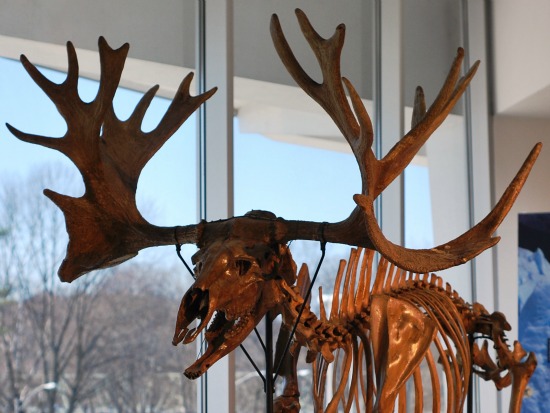Smilodon
is the most famous of North America’s long-lost sabercats.
But the burly carnivore wasn’t the only long-fanged
carnivore prowling the continent during the last Ice Age.
The remains of Homotherium serum – a cougar-sized cat
with shorter, serrated canines – have been found at
sites from Alaska to Texas, including a den near San Antonio
that contains the bones of baby sabercats as well as the dismembered
remnants of little mammoths that were dragged back to the
cave. And the record of Homotherium goes beyond bones. In
a Boreas paper published last year, paleontologist Chris Widga
and colleagues announced that they were able to retrieve genetic
scraps from the recently-extinct felid.
What remained
of the carnivore was discovered in Minnesota’s Tyson
Spring Cave. Excavators had to create a tunnel to explore
the Pleistocene deposit – the front entrance is underwater
– and in doing so they found a partial skull of the
“elk moose” Cervalces, a deer that sported an
impressive set of antlers. Once inside, researchers found
a partial skull, left shoulderblade, and right humerus of
Homotherium scattered through the cave. These bones represent
the first known record of the sabercat in the Great Lakes
region.

Genetic evidence
supported what the skeletal anatomy indicated. Widga and coauthors
were able to obtain a 311 base pair chunk of mitochondrial
DNA from the Tyson’s Spring Cave bones, and this genetic
fragment was a close match – differing in only two base
pairs – from a previously-discovered Homotherium specimen.
In the larger scheme
of cat evolution, Homotherium grouped most closely with the
famous Smilodon, confirming that sabercats truly were an evolutionary
lineage separate from other big cats. (This is why no one
says “saber-toothed tiger” anymore. The sabercats
split from a common ancestor with tigers and other big cats
in the distant past.) This doesn’t mean that Homotherium
and Smilodon were evolutionary siblings, though.
Based on anatomical
evidence, paleontologists have separated Homotherium and Smilodon
out into distinct sabercat lineages. Homotherium was a “scimitar-toothed
cat” that belonged to the group Homotherini, while Smilodon
was a “dirk-toothed cat” representing the Smilodontini
(which sounds like a cocktail with bite). The separate lineages
represented two different sabercat styles – Homotherium
was a big leggier and had shorter, serrated canines, while
Smilodon was a burlier predator with longer canines. The reason
the two came out as close relatives in the genetic analysis
is that researchers have yet to extract and analyze DNA from
other sabercats for comparison.
Of course, retrieving
genetic clues from other sabercats will rely on the discovery
of additional bones with preserved DNA. That might not be
possible for the earliest sabercats, but Homotherium lived
close enough to us in time that there’s hope of obtaining
more scraps. The Tyson Spring Cave bones, in particular, are
about 27,590-26,200 years old. Minnesota has changed quite
a bit since then, though. According to Widga and coauthors,
the cave was about 60 kilometers away from the nearest ice
sheet in the middle of a nearly “treeless steppe-tundra
environment” roamed by elk moose, mammoths, and the
muskox-like Bootherium. And on that chilly open landscape,
tracking the shaggy megamammals, was the last of America’s
scimitar cats.
|